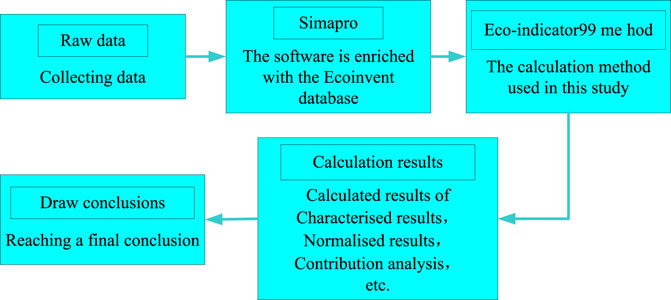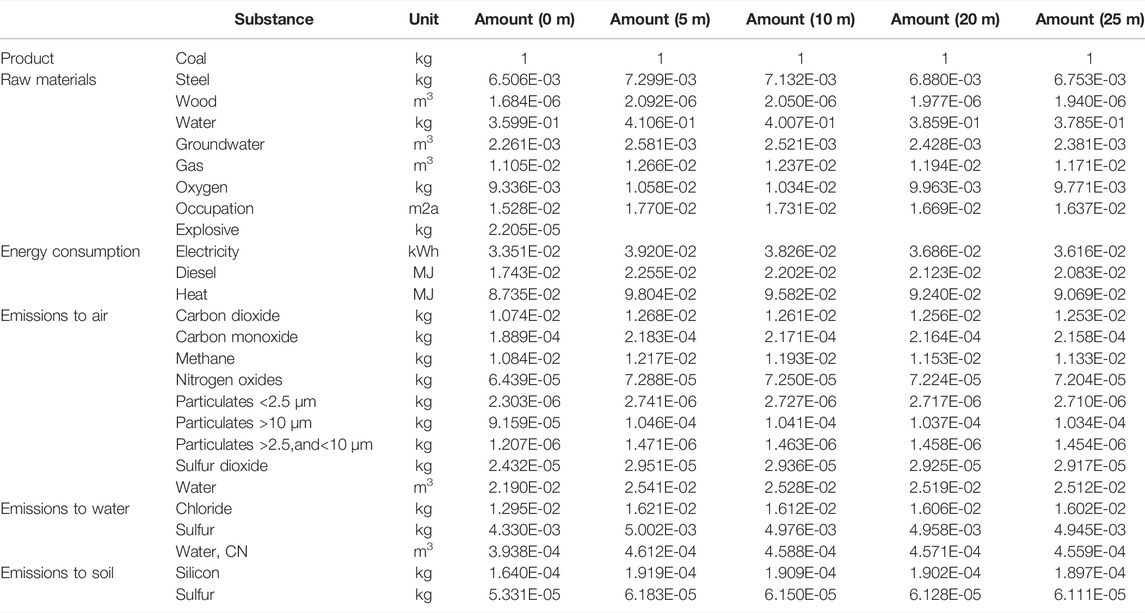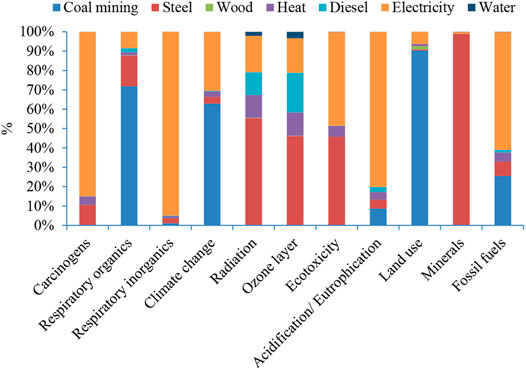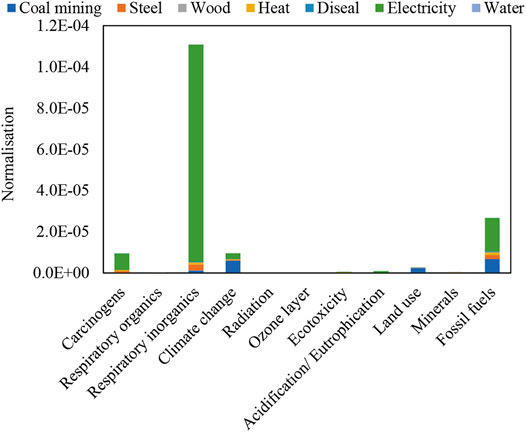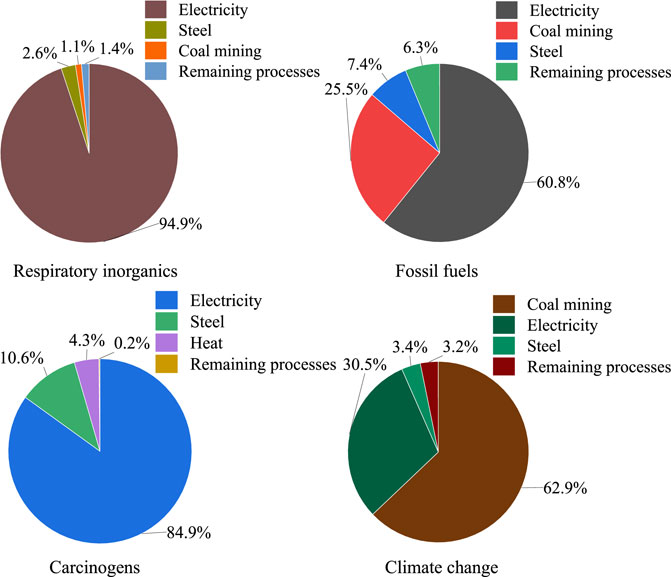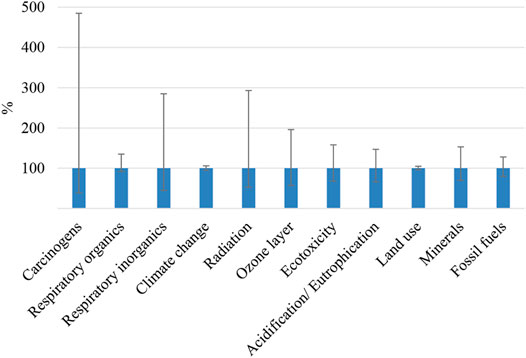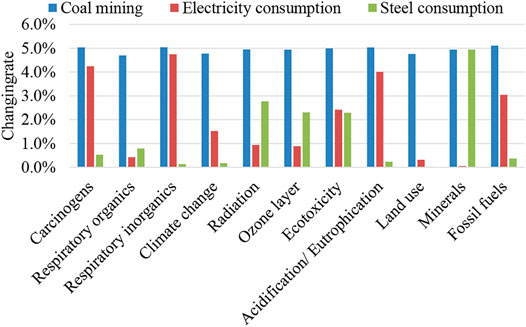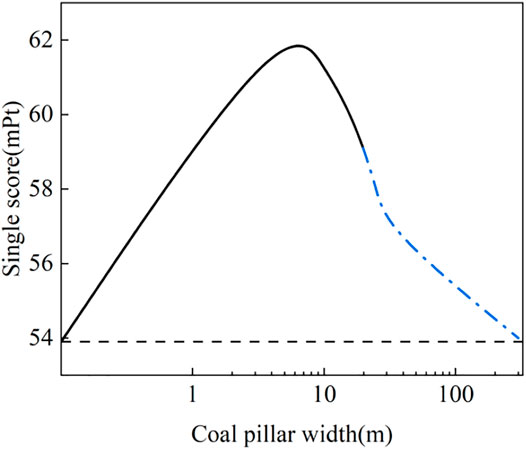- 1School of Mining Engineering, Anhui University of Science and Technology, Huainan, China
- 2Coal Mine Safety Mining Equipment Innovation Center of Anhui Province, Anhui University of Science and Technology, Huainan, China
Coal is China’s main source of energy, and its production causes a certain degree of air, water, and land resource pollution. Therefore, it is necessary to compare environmental pollution caused by different mining methods. When mining underground coal resources, different mining methods have different levels of environmental impacts. To identify the mining method with the least environmental impact, different mining methods were evaluated by means of a life cycle assessment using Simapro 9.0.0 software. The Ecoinvent v3 database was used to provide background data, and the results were calculated using the Eco-indicator99 method. The findings show that for a 20 m coal column, respiratory inorganics were identified as the dominant impact category based on normalized results, followed by fossil fuels, carcinogens, and climate change. The contribution analysis indicated that electricity and coal mining are fundamental in contributing to these significant impact categories and should be of particular concern. According to the sensitivity analysis, reducing mining activities and increasing extraction efficiency and use are the primary responses to addressing environmental pollution, followed by reducing environmental pollution caused by electricity and steel production. In addition, a summary comparison of the single scores of different mining methods suggests that the environmental burden of pillarless mining is the lowest, and as the width of the coal pillar gradually increases, its single score shows a trend of increasing and then decreasing. Therefore, the single score of non-pillar mining is the lowest compared to that of other mining methods and can be the optimal mining method. This study can provide a scientific basis for the selection of green mining and underground coal resource mining methods.
1 Introduction
Coal mining processes in the world’s major coal-producing countries are distinctive, with the negative environmental impacts caused by resource consumption and waste emissions varying among mining methods. Therefore, it is essential to choose an optimal mining method that makes the best use of resources and reduces the environmental burden. In recent years, the national demand for green and high quality industrial development has led researchers to focus on the safe and efficient production of coal. Reducing the environmental impact of the mining industry has also received increasing attention.
Coal will remain China’s primary energy source in the future. For a long time, coal mining in China has generally adopted the longwall mining technology system of digging the return roadway in advance at both ends of the return workings and leaving sections of coal pillars to protect the roadway (Zhen et al., 2019). The emergence of pillarless mining technology has initiated an essential change in coal mining technology in response to the low coal extraction and high roadway boring rates of the traditional pillar retention. This technology is achieved by mining coal while maintaining the original return roadway and retaining it for continued use in the next section of the workings, without leaving section guard coal pillars, thereby resulting in pillarless mining. Evaluating these two mining processes using different methods has received national and international research interest. Dubiński and Turek (2007) argued that the absolute safety and efficiency of production should be considered while minimizing its negative impact on the environment. Therefore, it is important to establish a management system that aims to prevent pollution and comply with environmental protection laws. A key requirement of environmental management is the continuous assessment of environmental activities (Staš et al., 2015). Currently, coal mining impact assessments focus on some of the most critical impacts caused by the processes involved (Burchart-Korol et al., 2016). Methane emissions into the atmosphere, drainage, and mining waste are important negative environmental impacts of coal mining (Kugiel, 2010), and methane is one of the most significant natural hazards of underground coal mining operations (Krause and Krzemień, 2013; Krause and Smoliński, 2013; Turek, 2010). Drainage is another important environmental impact of underground coal mining. In addition to natural water inflow, water supplied to the mine for processing is also essential (Jonek-Kowalska and Turek, 2013; Pluta and Dulewski, 2006). Furthermore, the disposal of mining waste requires the consideration of multiple environmental and economic aspects (Kowalska, 2014).
Life cycle assessment (LCA) is known as the cradle-to-grave approach to environmental assessment (Ma et al., 2010; Zhu, 2004) and is one of the most standardized methods for estimating the environmental burden associated with certain products. The Society of Environmental Toxicology and Chemistry (SETAC, 1993; Fava et al., 1993) defined LCA as a process of objectively evaluating the environmental impact of products, processes, and activities by identifying and quantifying energy and material use and the resulting environmental waste emissions. It evaluates the impact of energy and materials used on the environment by identifying and quantifying the resulting environmental waste emissions to find ways to improve them. The International Organization for Standardization (ISO 14040, 2006) defines LCA as one of the branches of system evaluation that analyzes environmental impacts in three main areas, namely, resource consumption, ecological health, and human health. While these studies have addressed the direct environmental impacts of mining activities, their methods did not indicate the indirect impacts on their inputs and outputs. Compared to environmental impact assessment or environmental auditing, LCA is superior because it broadens the boundaries of the system to include the loads or impacts of a product or process throughout its lifetime rather than only the emissions and waste generated by the manufacturing process (Yingshun, 2009). LCA is an environmental assessment method that quantifies the consumption of natural resources and emissions of pollutants during the production phase of a product and also assesses the process of making raw materials and analyzes the disposal of the product as waste at a later stage (Blengini et al., 2012). Previous studies have used LCA for iron ore, uranium, gold, copper, and aluminum (Ferreira and Leite, 2015; Haque and Norgate, 2014; Awuah-Offei et al., 2008; Spitzley and Tolle, 2004), as well as copper, nickel, and zinc (Suppen et al., 2006) for mineral extraction and processing. However, as each mineral corresponds to specific geological, mining, and processing conditions, the environmental impact of extracting each mineral product differs and, therefore, requires a specific individual analysis (Norgate and Haque, 2010). Awuah-Offei and Adekpedjou (2011) provided an overview of the applications, challenges, and current applications of LCA in the mining industry; lack of awareness and tools to perform LCA; definition of different functional units; and difficulty in the scope of the purpose of the analysis and selection of environmental impact categories (Awuah-Offei and Adekpedjou, 2011). Durucan et al. (2006) developed an LCA model of mining that incorporated mine production, processing, waste treatment and disposal, rehabilitation, and aftercare into an LCA framework, a tool that enabled an integrated representation of mining systems. Burchart-Korol et al. (2016) developed a model that combined SimaPro software with the Intergovernmental Panel on Climate Change and ReCiPe methods to assess impact categories, such as greenhouse gas emissions, human health, ecosystems, and resources. Tao et al. (2021) conducted a LCA of a typical coal mine in China, which identified the main impact categories of the mine and key processes contributing to the main impact categories.
The studies described above have led to many useful conclusions, and the LCA standard approach, based on ISO 14044, reveals that impact categories vary depending on the mining process (Mahmud et al., 2018; Farjana et al., 2018; ISO 14040, 2006). In summary, there remains a lack of research on the LCA of underground coal mining processes for different mining methods; thus, an optimal mining method has not yet been identified.
2 Materials and Methods
2.1 Life Cycle Assessment Method
The LCA methodology is a tool for assessing the environmental consequences of a product or an entire activity throughout its life. A complete LCA consists of four integral components, namely determination of purpose and scope, inventory analysis, impact assessment, and life cycle interpretation. LCA includes the following: identification and quantification of energy and resource use and environmental emissions to air, water, and land; characterization of technology quality and quantity; evaluation of the consequences of environmental impact analysis; and assessment of opportunities for environmental burden reduction and implementation. In this study, LCA was analyzed using SimaPro software, an internationally recognized database containing a large amount of data such as the Ecoinvent database and the input-output database, which is directly connected to the Eco-indicator 99 and ReCiPe Midpoint databases and contains well-known LCA calculation methods such as Eco-indicator 99 and ReCiPe Midpoint. The database provides a rich background of data, and the calculation methods are more efficient and accurate for quantitative calculations. Therefore, this software is widely used in the life cycle inventory assessment (LCIA) of coal mines.
In this study, quantitative calculations were performed using the Eco-indicator99 method, reflecting the direct and indirect environmental impacts of different mining methods. In this method, the inventory results were grouped into 11 impact categories, namely respiratory organics, respiratory inorganics, climate change, radiation, ozone layer, ecotoxicity, acidification/eutrophication, land use, minerals, and fossil fuels. When life cycle inventories of different mining methods are assigned to these impact categories, the results of the characterization analysis can reflect the relative contribution of each of these processes to the impact category. A normalized analysis reflects the specific value of each input unit in the overall environmental impact and allows for a comparison between different life cycles. Consequently, both aspects provide a clear picture of the environmental impacts of the different mining methods (Figure 1).
2.2 Functional Unit and System Boundary
Before an LCA evaluation, selecting functional units and delineating system boundaries are essential steps. The selection of functional units is ultimately used to compare and analyze the LCA results and provide an accurate quantitative reference for the inputs and outputs of the relevant processes that have been investigated (ISO 14040, 2006). The main role of the functional units is to provide a uniform measure of input and output in a mathematical sense, providing a frame of reference for the relevant inputs and outputs to ensure comparability of the LCA results. With reference to the measurement size of the data in the Ecoinvent database, this study used the mining of 1 kg of coal as a functional unit; thus, all inputs and outputs were based on the mining of 1 kg of coal. The study was divided into two mining methods, namely non-pillar (reserved coal pillar width of 0 m) and reserved coal pillar mining, where the reserved coal pillar width was 5, 10, 20, and 25 m. All the input and output units were determined, and the environmental impacts caused by different mining methods in coal mining were evaluated.
There are complex subsystems interconnected with a production system and interconnected as subsystems with other production systems, making it is very difficult to identify all the interconnected inputs and outputs. Figure 2 shows the system boundary, which includes three subsystems, with the production of materials and energy within the system boundary and the production of equipment and maintenance of equipment not included within the boundary.
2.3 Life Cycle Inventory Analysis
The life cycle inventory (LCI) is the basis for LCIA and for improving and optimizing engineering practices. The inventory analysis is an iterative process. Production data and waste emissions from coal with different mining methods are monitored. Where information is insufficient, data are supplemented by referencing government planning documents and literature, in addition to background information on production materials and energy sources provided by the Ecoinvent database. All the data were measured in functional units of 1 kg of coal mining. The LCI is given in Table 1, where the data on material production, energy consumption, and direct emissions are calculated on a functional unit basis.
Daily production parameters, operating procedures, and direct emissions are the main sources of field data, which are monitored by specialist departments studying coal mines. Data, including those on steel and wood, were derived from operating procedures and emissions from direct emissions, in addition to raw data such as electricity and sulfur dioxide, which were referred from existing research in China (Tao et al., 2021). The Ecoinvent database is one of the most advanced life-cycle inventory databases, covering basic data from China and other countries and providing background data on the production of energy and raw materials (Ecoinvent Center, 2015).
The LCI is the collection of the data required at each stage of the life cycle and calculation of the data collected. The collection process is the most labor-intensive part of the process. It involves not only the production of the materials and energy required for the different mining methods, materials, and energy consumed in various processes, but also the collection and calculation of data on various waste emissions.
3 Results
3.1 Characterized Results
The LCIA directly reflects the environmental relevance of all inputs and outputs. In this study, the environmental impact results were classified into 11 impact categories according to the Eco-indicator99 method and included carcinogens, respiratory organics, and respiratory inorganics. The parameters involved in the LCI, such as material production, energy consumption, and waste emissions, were assigned to these impact categories in the SimaPro software calculations to obtain the LCIA results.
In the Eco-indicator99 method, normalization and weighting were performed in levels within the damage categories. The three damage categories were as follows:
1. HH, human health (unit: DALY = disability-adjusted life years, which means different disabilities caused by diseases are weighted).
2. EQ, ecosystem quality (unit: PDF × m2 × yr; PDF = Potentially Disappeared Fraction of plant species).
3. R, Resources (unit: MJ surplus energy and additional energy requirement to compensate for lower future ore grade).
Table 2 provides the LCIA results, from which the potential impact of each impact category can be understood. For example, the impact values for carcinogens were 7.710E-08, 8.961E-08, 8.748E-08, 8.429E-08, and 8.270E-08 DALY for mining methods at 0, 5, 10, 15, 20, and 25 m coal pillar widths, respectively.
In the characterized results, all impact categories were counted at 100% to provide a more intuitive analysis of the proportion of each process in each impact category. However, the results of this study do not allow for an intuitive identification of which impact category or process has the greatest impact on the overall environment. Only which unit or process contributes the most to a particular impact category can be observed. Using a 20 m coal pillar as an example, Figure 3 shows the characterized results for each unit or process in the coal mining process. Figure 4 shows the characterized results for coal mining at pillar widths of 0–25 m.
All units or processes contribute in some way to each of the 11 impact categories, and the share of each unit in particular impact categories is clearly demonstrated in Figure 3. For example, electricity was found to make a substantial contribution to the impact of carcinogens, followed by steel. Pollution is not only related to direct emissions but also to the production of materials and energy at the previous level. In this way, the magnitude of the contribution of the impact units or processes in each of the 11 impact categories could be visualized. The contributions of the impact categories, impact units, and systems for the remaining coal pillar width mining processes were similar to those for the 20 m pillar width mining process; therefore, they were not repeated here.
The 11 impact types of coal mining at five coal pillar widths were compared centrally (Figure 4), with the most severe mining method for each impact type being counted at 100% in the comparison process. The impact of the remaining mining methods on each impact type was compared according to the most severe mining method. The environmental impact of each mining method could only be compared for one impact type, but it was seen that the environmental impact of pillarless mining is the lowest for each impact type, and therefore, the overall environmental contribution of pillarless mining is also the lowest. Based on this method, Figure 4 shows a comparison of the characterized results for coal mining at 0–25 m pillar widths, with each influence category increasing and then decreasing as the width of the coal column increases. The 5 m coal pillar mining method led the way for each impact type, and therefore, had the greatest overall environmental impact, followed by the 10, 20, and 25 m pillar width mining methods. The overall environmental impact of pillarless mining was the lowest. The proportion of respiratory organic impacts for each mining method was the highest compared to the other impact types in coal-free pillar mining, mainly because of organic particulate matter generated by blasting during the coal-free pillar mining process. Conversely, the 5 m coal pillar mining process had the highest impact of each category, mainly because the pillar was so small that it no longer had the capacity to carry the overlying rock seam. It required a large amount of steel, electricity, and wood to support the material in order to reach the carrying capacity of the mining and consumed a large amount of energy and material. As the width of the coal column increased, the ability to carry the overlying rock seam gradually increased, requiring less ancillary support material and energy, and the contribution to the environment from producing the corresponding energy and material gradually decreased, showing a gradual decrease in the contribution to the environment in each impact type.
3.2 Normalized Results
In the characterized results, it was not possible to directly observe the extent to which each impact category contributes to the overall impact. Therefore, a further standardized analysis was required, in which the contribution of each impact category to the overall process can be quantified and the magnitude of the contribution of the impact categories can be visually analyzed and compared. As an example of coal mining with a 20 m coal pillar width, respiratory inorganics caused the greatest environmental burden in the coal mining process, followed by fossil fuels, carcinogens, and climate change (Figure 5).
3.3 Contribution Analysis
3.3.1 Contributions of Subsystems
A contribution analysis plays an important role in an uncertainty analysis, where all contributions of individual processes are superimposed on the results of the contribution analysis calculation. By focusing on these processes, it is possible to reduce negative environmental impacts by identifying the production processes that play an important role in evaluating the results. Using a 20 m coal pillar width as an example, Figure 6 shows the characterized results of the three interacting subsystems in the coal mining process.
The results showed that the three subsystems are responsible for most of the carcinogen, respiratory organic, respiratory inorganic, climate change, radiation, ozone layer, ecotoxicity, acidification/eutrophication, land use, mineral, and fossil fuel effects (Figure 6). The face mining system was responsible for the majority of these 11 impact categories and for a substantial proportion of all the impact categories. This mining system accounted for a substantial proportion of all impact categories and 98.5% of the impact in carcinogens, indicating that the face mining system is the largest contributor to each impact category of the three subsystems. In contrast to the face mining system, the preparation and pillar mining systems had a smaller environmental burden and contributed to all 11 impact categories.
3.3.2 Contributions of Processes
Respiratory inorganics, fossil fuels, and carcinogens were found to be the most significant impact categories (Figure 5), in addition to climate change, which has received much attention in recent years. Therefore, the categories described above were identified as key categories. In the analysis, the key processes affecting the key categories could not be accurately captured, and therefore, a process contribution analysis was conducted within the system boundary. The process contribution analysis was used to identify the critical processes within the main impact categories so that improvements can be made to reduce negative environmental impacts effectively (Figure 7).
According to the process contribution results (Figure 7), electricity was the leading cause of respiratory inorganics, fossil fuels, and carcinogens, accounting for 94.9%, 60.8%, and 84.9%, respectively. The waste generated from coal-fueled thermal power generation, whose production process uses fuels, was the leading cause of respiratory inorganic, fossil fuel, and carcinogen impacts. The main contributor to climate change was coal mining, which is caused by large amounts of polluting gases such as CO2 and methane emitted into the air through the ventilation process.
4 Discussion
4.1 Uncertainty Analysis
An uncertainty analysis examines how uncertainty in the input data affects the results of the model and helps to understand the importance of the data source or model. The dataset was drawn from the field, literature, and databases and then averaged together to create a combined dataset; therefore, it was necessary to conduct an uncertainty analysis to ensure its accuracy. The uncertainty analysis was conducted using Simapro 9.0.0 software. The input data were analyzed using the uncertainty analysis method in the Eco-indicator99 method with a 95% confidence level and displaying the mean, median, and standard deviation. The uncertainty results using a 20 m coal column and calculated using the Eco-indicator99 method are displayed in Table 3 and Figure 8.
For the 20 m coal pillar mining process, the results based on Table 3 show no significant change in the significant impact categories of carcinogens, respiratory inorganics, fossil fuels, and climate change. Figure 8 shows the results of the Eco-indicator99 based method for the 20 m coal column mining process, with the marked categories being carcinogens, radiation, and respiratory inorganics. By comparing the uncertainty of carcinogens with the other impact types, followed by radiation and respiratory inorganics, the uncertainty results for the remaining impact types were found to be low and have high stability compared to the uncertainty results for these three impact categories. For low uncertainty data, there is a high degree of stability, whereas for high uncertainty data, double-checking is required to ensure the accuracy of the data and provide a reference for future related studies.
4.2 Sensitivity Analysis
A sensitivity analysis can provide a basis for scientific decisions to reduce environmental burden. This is an indication of how changes in individual parameters and parameter sets affect the final results; that is, the importance or sensitivity of a parameter to the overall model can be determined by analyzing the impact of a change in the parameter when all other parameters are constant. The sensitivity analysis was conducted using Simapro 9.0.0 software, and the results were calculated using the Eco-indicator99 method. The results of the sensitivity analysis were calculated using the software and the methods described above. The sensitivity analysis was conducted for crucial impact categories and key processes based on functional units, reducing the input data for each key process by 5% and observing changes in the contribution of key impact categories. Taking 20 m coal pillar mining as an example, Figure 9 shows the sensitivity analysis results for the key processes.
The graph (Figure 9) demonstrated that that a 5% reduction in coal mining can provide significant environmental benefits for all impact categories, such as carcinogens, respiratory organics, respiratory inorganics, and climate change, with the rates of change being 5.03%, 4.70%, 5.04%, and 4.78%, respectively. The sensitivity of the coal mining process was high and particularly important because changes in coal mining have a greater impact on all impact types. When electricity consumption was reduced by 5%, the rates of change for respiratory inorganics, carcinogens, acidification/eutrophication, fossil fuels, and climate change were 4.75%, 4.25%, 4.01%, 3.04%, and 1.52%, respectively. Therefore, changes in electricity consumption have a greater impact on the important impact types and a higher sensitivity and are crucial for the important impact categories. When steel consumption was reduced by 5%, the rate of change was 4.94%, 2.77%, and 2.30% for the minerals, radiation, and ozone layer categories, respectively, with some sensitivity and importance for some of these impact categories.
Based on the results of the sensitivity analysis, to adopt scientific countermeasures for reducing the burden on the environment, the first step is to minimize the mining of coal resources. Coal mining has a greater burden on the environment, and scientific methods should be adopted to use clean energy as much as possible and improve the efficiency of the mining and utilization of coal. The consumption of electricity also has a significant impact on the environment; therefore, we should try to use less burdensome methods of power generation, such as wind power and water power generation, and improve the efficiency of electricity use. Finally, steel consumption damages the environment, and it is necessary to reduce the environmental impact of the steel production process and improve its efficiency.
4.3 Interpretation
With rapid economic development, environmental issues have become key global topics. As one of the primary energy sources, the production and consumption of coal has caused substantial environmental pollution. As different production methods are used, their impacts on the environment vary. This study investigated the environmental impact of underground coal resources under different mining methods and identified the production method with the least burden on the environment and, consequently, the optimal mining method.
The life cycle evaluation process is similar to different coal pillar mining methods, and this study used the mining method with a 20 m coal pillar left in place as an example of a life cycle evaluation of its production process. The characterization results (Figure 3) provide an understanding of the extent of each process for each of the 11 impact categories and the share of each unit in a particular impact type is also shown. For example, electricity makes the largest contribution to the impact of carcinogens, followed by steel. The results of the characterization of all coal pillar widths were compared (Figure 4), which initially concluded that the no-pillar mining method has the least environmental burden. A standardized analysis was then used to quantify the degree of impact of each impact category on the overall environment, with respiratory inorganics, carcinogens, and fossil fuels being the most dominant impact categories. With an understanding of the main impact categories, a contribution analysis was conducted to identify the face mining system as the subsystem with the greatest environmental burden through the contributions of subsystems and processes. The main processes affecting the main categories of impact were identified, with the main processes affecting respiratory inorganics being, for example, electricity. This analysis explains the main impact categories and processes and provides a basis for scientific decisions to reduce the environmental burden. However, to verify the accuracy of the data and provide a solid scientific strategy, uncertainty and sensitivity analyses were conducted. The sensitivity analysis results showed that a 5% reduction in the input data for the main impact processes would result in a greater environmental benefit. Therefore, with the mining method of leaving a 20 m coal pillar as an example, based on the above analysis, the mining method without a coal pillar was considered to have the least negative impact on the environment. Consequently, it was initially concluded that the mining method without a coal pillar is the optimal mining method. Respiratory inorganics, carcinogens, and fossil fuels were the most important impact types, and after determining the main impact, the main impact types were identified. The face mining system was the subsystem with the greatest environmental burden. Mining, electricity, and steel were considered to have high sensitivity or importance.
The main objective of this study was to determine the optimal extraction method. Using the 20 m coal pillar mining method as an example, the main categories of influence and processes affecting the mining method were recognized through characterized, normalized, and contribution analyses. The influence of respiratory inorganics had a greater weighting under the non-pillar mining method (Figure 4), mainly because of the blasting technique used in the non-pillar mining process, which generates more organic particles. The LCA process for the other mining methods is similar to the 20 m column mining method, and there is little difference in the primary impact categories and processes. The single score value for the mining method without coal pillars, that is, 0 m pillar width, was the smallest (Figure 10). Combined with the results of the characterization comparison, it is clear that mining without coal pillars has the lowest level of environmental impact, and therefore, mining without coal pillars is determined to be the optimal mining method. The final single score summary comparison shows that as the width of the coal pillar increases, the degree of negative environmental impact increases and then decreases. As the width of the pillar continues to increase to a certain width, the recovery methods used because of its increased carrying capacity change and the materials and energy used are reduced accordingly, making the mining process less environmentally burdensome. It is predicted that as the width of the pillar increases to a width equal to that of the working face, the mining method will be equivalent to pillarless mining, and the level of negative environmental impact will approach that of pillarless mining (Figure 10).
5 Conclusion
This study used LCA to select the optimal mining method for different coal pillar widths. A list of input and output stream data, with 1 kg of coal mined as a functional unit, was created using the SimaPro software and Ecoinvent database, and impact analyses were evaluated based on the list analysis. The Eco-indicator 99 method was used to assign the input and output data in the LCI to 11 different environmental impact types. Characterized, normalized, and contribution analyses were conducted using a 20 m coal pillar width mining method as an example. To verify the accuracy of the data and scientific decisions, an uncertainty analysis and summary comparison of the single scores of the different mining methods were conducted to obtain the optimal mining method and the environmental impact variations between the different mining methods. The following conclusions were obtained.
(1) Through characterized and normalized analyses, the degree of impact of each process on 11 impact types was obtained. It is tentatively concluded that mining without coal pillars has the lowest negative impact on the environment, and using the mining method with a 20 m pillar width as an example, it was found that respiratory inorganics, carcinogens, and fossil fuels are the most dominant impact types. The contribution analysis shows that the face mining system has the greatest environmental burden. The main influencing processes for respiratory inorganics, carcinogens, and fossil fuels is electricity, accounting for 94.9%, 60.8%, and 84.9%, respectively. The main process influencing climate change is coal mining, which accounted for 62.9% of the total.
(2) Uncertainty and sensitivity analyses were used to verify the accuracy of the data and provide accurate scientific decisions. The uncertainty analysis provides a basis for data accuracy. The sensitivity analysis results showed that when the coal mining process unit data are reduced by 5%, the rate of change of carcinogens, respiratory organics, and respiratory inorganics are 5.03%, 4.70%, and 5.04%, respectively. For a 5% reduction in electricity consumption process data, the rates of change for respiratory inorganics, carcinogens, and acidic/eutrophication are 4.75%, 4.25%, and 4.01%, respectively. For a 5% reduction in consumption process data for steel, the rates of change for minerals, radiation, and ozone layer are 4.94%, 2.77%, and 2.30%, respectively. A 5% reduction in input data for these three main impact types resulted in greater rates of change for the main impact categories, all of which would result in greater environmental benefits.
(3) A comparative analysis of the single score values for environmental burden shows that non-pillar mining had the lowest environmental burden and was determined to be the optimal mining method. As the width of the coal pillar gradually increases, the single score value for the environmental burden increases and then decreases. As the width of the coal pillar gradually increases to approach the width of the working face, the degree of negative environmental impact gradually approaches that of non-pillar mining.
Data Availability Statement
The original contributions presented in the study are included in the article/supplementary material, further inquiries can be directed to the corresponding author.
Author Contributions
HW: conceptualization, methodology, software, data curation, validation, and writing-original draft. ZY: supervision, writing-review and editing, and funding acquisition. YZ, CQ, XL, and JW: data curation.
Funding
This work was supported by the National Natural Science Foundation of China (Grant Nos 51874006 and 51774009), and Anhui Provincial Natural Science Foundation (Grant No. 2008085QE226), and Key Research and Development Projects in Anhui Province (Grant No. 202004a07020045), which are gratefully acknowledged.
Conflict of Interest
The authors declare that the research was conducted in the absence of any commercial or financial relationships that could be construed as a potential conflict of interest.
Publisher’s Note
All claims expressed in this article are solely those of the authors and do not necessarily represent those of their affiliated organizations, or those of the publisher, the editors, and the reviewers. Any product that may be evaluated in this article, or claim that may be made by its manufacturer, is not guaranteed or endorsed by the publisher.
References
Awuah-Offei, K., and Adekpedjou, A. (2011). Application of Life Cycle Assessment in the Mining Industry. Int. J. Life Cycle Assess. 16, 82–89. doi:10.1007/s11367-010-0246-6
Awuah-Offei, K., Checkel, D., and Askari-Nasab, H. (2008). Evaluation of Belt Conveyor and Truck Haulage Systems in an Open Pit Mine Using Life Cycle Assessment [J]. Cim. Bull. 102 (8), 1–6.
Blengini, G. A., Garbarino, E., Šolar, S., Shields, D. J., Hámor, T., Vinai, R., et al. (2012). Life Cycle Assessment Guidelines for the Sustainable Production and Recycling of Aggregates: The Sustainable Aggregates Resource Management Project (SARMa). J. Clean. Prod. 27, 177–181. accessed 10.12.13. doi:10.1016/j.jclepro.2012.01.020
Burchart-Korol, D., Fugiel, A., Czaplicka-Kolarz, K., and Turek, M. (2016). Model of Environmental Life Cycle Assessment for Coal Mining Operations[J]. Sci. Total Environ. 562, 61–72. doi:10.1016/j.scitotenv.2016.03.202
Dubiński, J., and Turek, M. (2007). “Szanse Rozwojowe Przedsiębiorstw Górniczych Winnowacjach,” in Polski Kongres Górniczy. Sesja 5. (Innowacyjne Górnictwo. Research Re-ports of Central Mining Institute) No. I (in Polish).
Durucan, S., Korre, A., and Munoz-Melendez, G. (2006). Mining Life Cycle Modelling: A Cradle-To-Gate Approach to Environmental Management in the Minerals Industry[J]. Clean. Prod. 14 (12-13), 1057–1070 (Euracoal.eu [accessed on: 15/03/2016]). doi:10.1016/j.jclepro.2004.12.021
Ecoinvent Centre (2018). Introduction to Ecoinvent Version 3. Available at: https://www.ecoinvent.org/database/introduction-to-ecoinvent-3/introduction-to-ecoinvent-version-3.html.
Farjana, S. H., Huda, N., Mahmud, M. A. P., and Lang, C. (2018). Comparative Life-Cycle Assessment of Uranium Extraction Processes. In Australia[J]. J. Clean. Prod. 202, 666–683. doi:10.1016/j.jclepro.2018.08.105
Fava, J., Consoli, F., and Dennison, R. (1993). A Conceptual Framework for Life-Cycle Impact Assessment. Pensacola: SETAC and SETAC Foundation for Environmental Education.
Ferreira, H., and Leite, M. G. P. (2015). A Life Cycle Assessment Study of Iron Ore Mining[J]. J. Clean. Prod. 108, 1081–1091. doi:10.1016/j.jclepro.2015.05.140
Haque, N., and Norgate, T. (2014). The Greenhouse Gas Footprint of In-Situ Leaching of Uranium, Gold and Copper in Australia. J. Clean. Prod. 84, 382–390. doi:10.1016/j.jclepro.2013.09.033
ISO 14040 (2006). Environmental Management-Life Cycle Assessment-Principles and Frame Work. Geneva, Switzerland: International Organization for Standardization.
Jonek-Kowalska, I., and Turek, M. (2013). Cost Rationalization of Maintaining Post-industrial Regions. Pol. J. Environ. Stud. 22 (3), 727–740.
Kowalska, I. J. (2014). Risk Management in the Hard Coal Mining Industry: Social and Environmental Aspects of Collieries' Liquidation. Resour. Policy 41, 124–134. doi:10.1016/j.resourpol.2014.05.002
Krause, E., and Krzemień, K. (2013). Methane Risk Assessment in Underground Mines by Means of a Survey by the Panel of Experts (SOPE). J. Sustain. Min. 13 (2), 6–13. doi:10.46873/2300-3960.1262
Krause, E., and Smoliński, A. (2013). Analysis and Assessment of Parameters Shaping Methane Hazard in Longwall Areas. J. Sustain. Min. 12 (1), 13–19. doi:10.7424/jsm130104
Kugiel, M. (2010). Activities of Kompania Węglowa S.A. In the Sphere of Environment Pro-tection, with Particular Emphasis on Commercial Exploitation of Methane[J]. Górnictwoi Geologia 5 (1), 73–87 (in Polish)
Li, Y. (2009). Environmental Impact Assessment Study of Copper Recovery from Copper Slag [D]. Dissertaiton. Beijing: China University of Mining and Technology.
Ma, F., Wang, J., and Zhang, Y. (2010). Knowledge Map of Domestic Life Cycle Theory Studies. Inf. Sci. 28 (3), 334–340.
Mahmud, M., Huda, N., Farjana, S., Lang, C., Mahmud, M. A. P., Huda, N., et al. (2018). Environmental Impacts of Solar-Photovoltaic and Solar-Thermal Systems with Life-Cycle Assessment. Energies 11, 2346. doi:10.3390/en11092346
Norgate, T., and Haque, N. (2010). Energy and Greenhouse Gas Impacts of Mining and Mineral Processing Operations. J. Clean. Prod. 18, 266–274. doi:10.1016/j.jclepro.2009.09.020
Pluta, I., and Dulewski, J. (2006). Mine Waters in the Light of Old and Current Terminology and Their Classification Obeying in Coal Mining [J]. Min. News 57 (1), 37–41. (in Polish)
Society of Environmental Toxicology and Chemistry (SETAC) (1993). Guidelines for Life-Cycle Assessment: A Code of Practice. Brussels: SETAC Europe, 11.
Spitzley, D. V., and Tolle, D. A. (2004). Evaluating Land-Use Impacts: Selection of Surface Area Metrics for Life-Cycle Assessment of Mining[J]. Ind. Ecol. 8 (1-2), 11–21. doi:10.1162/1088198041269481
Staš, D., Lenort, R., Wicher, P., and Holman, D. (2015). Green Transport Balanced Scorecard Model with Analytic Network Process Support[J]. Sustainability 7, 15243–15261. doi:10.3390/su71115243
Suppen, N., Carranza, M., Huerta, M., and Hernandez, M. (2006). Environmental Management and Life Cycle Approaches in the Mexican Mining Industry[J]. Clean. Prod. 14 (12-13), 1101–1115. doi:10.1016/j.jclepro.2004.12.020
Tao, M., Cheng, W., Nie, K., Zhang, X., and Cao, W. (2021). Life Cycle Assessment of Underground Coal Mining in China [J]. Sci. Total Environ. 804. doi:10.1016/j.scitotenv.2021.150231
Turek, M. (2010). Fundamentals of Underground Coal Mining. first ed. Katowice: Publishing House of the Central Mining Institute. (in Polish).
Yingshun, L. (2009). Environmental Impact Assessment Study of Copper Recovery From Copper Slag [D]. China University of Mining and Technology (Beijing).
Keywords: life cycle assessment, coal production, optimal mining method, environmental impact, green mining
Citation: Wu H, Yin Z, Zhang Y, Qi C, Liu X and Wang J (2022) Comparison of Underground Coal Mining Methods Based on Life Cycle Assessment. Front. Earth Sci. 10:879082. doi: 10.3389/feart.2022.879082
Received: 18 February 2022; Accepted: 12 May 2022;
Published: 30 May 2022.
Edited by:
Candan Gokceoglu, Hacettepe University, TurkeyReviewed by:
Marek Laciak, Technical University of Košice, SlovakiaSatar Mahdevari, Amirkabir University of Technology, Iran
Copyright © 2022 Wu, Yin, Zhang, Qi, Liu and Wang. This is an open-access article distributed under the terms of the Creative Commons Attribution License (CC BY). The use, distribution or reproduction in other forums is permitted, provided the original author(s) and the copyright owner(s) are credited and that the original publication in this journal is cited, in accordance with accepted academic practice. No use, distribution or reproduction is permitted which does not comply with these terms.
*Correspondence: Zhiqiang Yin, emhxeWluQGF1c3QuZWR1LmNu
†ORCID:Haoyuan Wu, orcid.org/0000-0002-6934-2493; Yuchen Zhang, orcid.org/0000-0001-5881-8989; Chao Qi, orcid.org/0000-0003-2890-6536; Xian Liu, orcid.org/0000-0003-3713-3088; Jianen Wang, orcid.org/0000-0002-6459-6865
 Haoyuan Wu
Haoyuan Wu Zhiqiang Yin
Zhiqiang Yin Yuchen Zhang1†
Yuchen Zhang1†